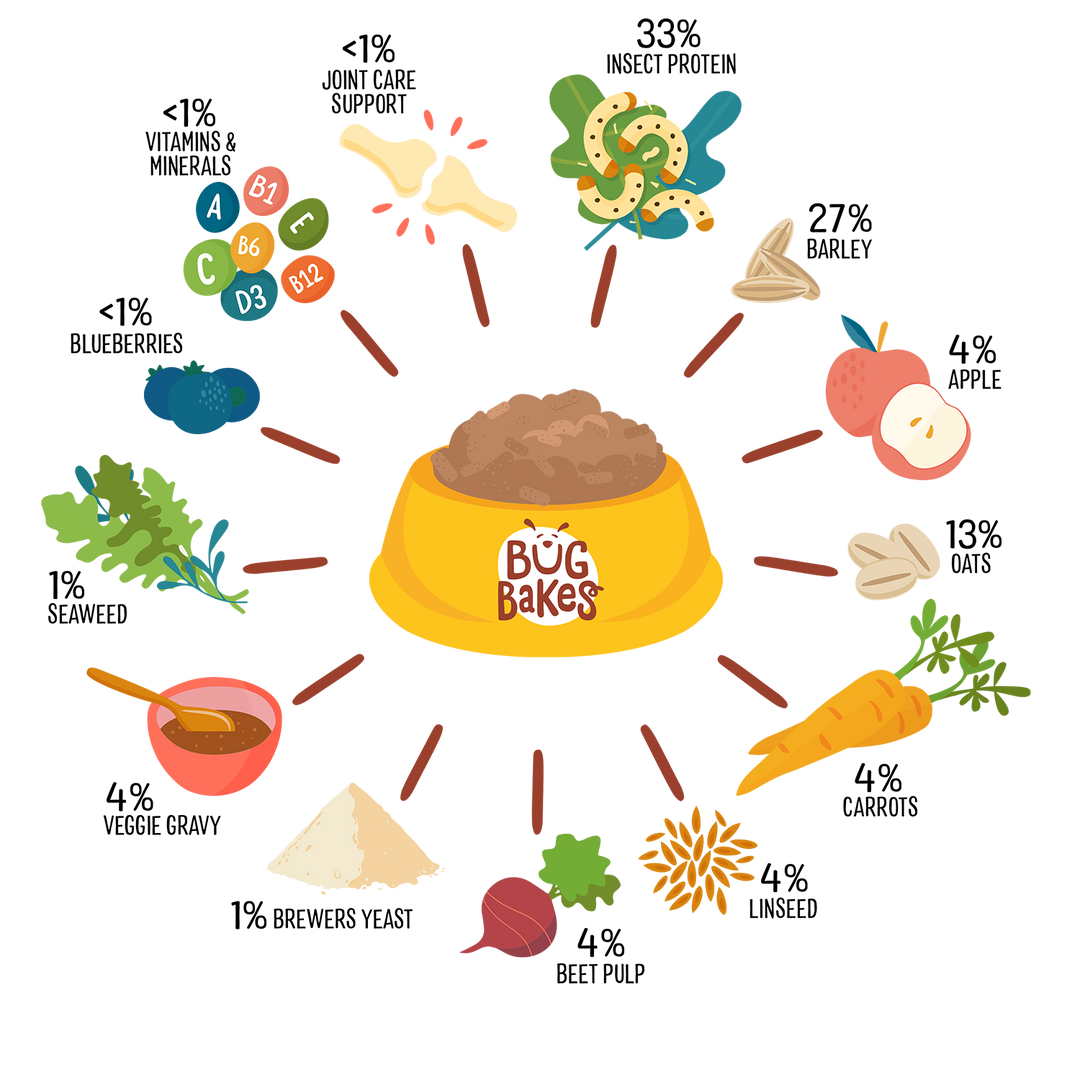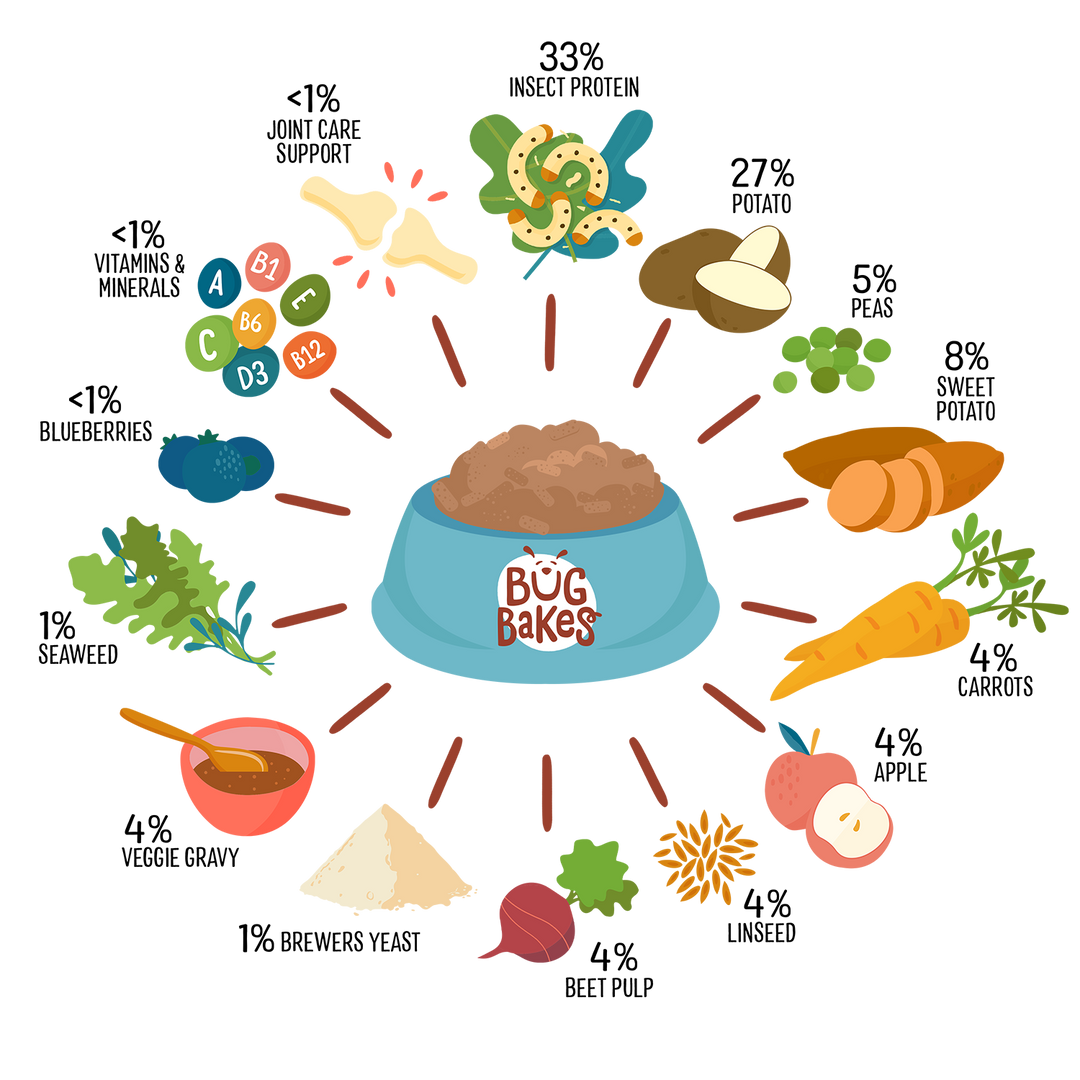Sensitive Skin Dog Food
Is your dog miserable from constant licking and itching from their sensitive skin? Our specially formulated food offers a vet-approved solution. Made with cold-pressed, natural ingredients and insect protein, you can reduce the risk of your dog’s skin causing them discomfort with our nutritious and delicious recipe.
- Fast Relief: Soothe itchy skin and promote a healthy coat
- Gentle on Tummies: Hypoallergenic and grain-free options are also available
- Complete Nutrition: Packed with all the essential nutrients your dog needs
Testimonials

Ethical

Environmentally-Friendly

Vet-Approved

Hypoallergenic

Subscribe & Save

Protein-Packed
Is Your Dog Suffering from Itchy, Unhappy Skin?
Does your furry friend constantly scratch, lick, or chew at their paws and belly? Have you noticed red, inflamed patches or even hair loss? These are all signs your dog might be struggling with sensitive skin.
But, don't worry, there's hope! Here's how our specially formulated food can help:
Constant Itching & Scratching
Traditional dog food can trigger allergies, leading to relentless itching. Our food provides protein from sustainably-farmed insects, which is a lot easier for your dog to digest.
Red, Inflamed Skin
Many dog food brands use ingredients that irritate sensitive skin. Our recipes are hypoallergenic and there’s even a grain-free blend, eliminating common allergens like wheat and chicken. This soothes inflammation and promotes healthy skin.
Dry, Flaky Skin & Hair Loss
Sensitive skin often leads to dryness and flaking. Our food is packed with omega-3 fatty acids from the insect protein and linseed, promoting a healthy coat and reducing irritation-related hair loss.
What Goes into Our Sensitive Skin Dog Food?
We have prioritised novel protein sources and natural ingredients in our food for dogs with sensitive skin to prevent allergic reactions and cater to intolerances. It supplies all the nutrients dogs need, allowing you to avoid treats, dental chews and extra food that are difficult to track and could aggravate their sensitive skin. Here are our nutritional values and recipes:
Protein 28%, Fat 11%, Fibre 5%, Ash 7%

Regular Food:
- Insect - 33% (28% meal, 5% oil)
- Barley - 27%
- Oats - 13%
- Apple - 4%
- Carrot - 4%
- Linseed - 4%
- Beet Pulp - 4%
- Seaweed - 1%
- Chicory Root Extract
- Vegetable Gravy - 4%
- Blueberries
- Glucosamine 400 mg/kg
- Chondroitin 200 mg/kg
Grain-Free Food:
- Insect 33% (28% meal, 5% oil)
- Potato 27%
- Sweet Potato 8%
- Peas 5%
- Apple 4%
- Carrot 4%
- Linseed 4%
- Beet Pulp 4%
- Vegetable Gravy 4%
- Minerals
- Vitamins
- Brewers Yeast 1%
- Seaweed 1%
- Blueberry
- Prebiotic MOS
- Chicory Root Extract
- Glucosamine 400 mg/kg
- Chondroitin 200 mg/kg

Suitable For
No matter your dog’s breed, size, gender or activity level, our skin-sensitive dog food is ideal. If your pup is over two months old, we can support them. Plus, you can use our calculator to determine their ideal daily intake and discover how affordable it can be. Then, sign up for our subscription and save 10% on every bag you purchase.

Puppies

Working Dogs

Seniors
FAQ
How should I switch my dog’s food to avoid illness?
A gradual transition between foods will help to prevent sickness. Here is a simple feeding guide you can follow:
Day 1-2: 25% new diet, 75% old diet
Day 3-4: 50% new diet, 75% old diet
Day 5-6: 75% new diet, 25% old diet
Day 7 onwards: 100% new diet
What are the most common food allergies affecting dogs?
Dogs are often allergic to everyday food sources, such as beef, pork, chicken, wheat, grain, dairy, eggs and soy. Many dog kibble recipes include these ingredients, and choosing a food for dogs with sensitive skin can cater to these allergies.
Apart from food, what causes allergies and itchy skin in dogs?
Food is one of the least common allergies that affect dogs. Fleas and environmental allergies to things like dust and pollen are more prevalent.
How do food allergies and food intolerances differ?
Food allergies are immune system reactions to particular foods and subsequently have more severe life-threatening symptoms. Alternatively, intolerances are digestive reactions with milder symptoms.
How are the symptoms of dog food allergy and intolerance different?
Intolerances typically produce digestive issues, including gas, bloating, nausea, diarrhoea and vomiting. An allergy usually has symptoms of red skin rashes, itching, licking, hives, paw biting and occasionally digestive problems like nausea and vomiting.
My dog is constantly scratching and their skin looks irritated. What can I do?
Itchy skin can be caused by allergies or other factors. See your vet for a diagnosis. They may recommend an elimination diet or a food with novel proteins and grain-free options, like our sensitive skin dog food.
What are novel proteins and why are they good for itchy skin?
Novel proteins are new protein sources like insects, salmon or lamb, and are less likely to trigger allergies in dogs with sensitive skin. Our choice of sustainably farmed insect protein is particularly easy for your dog to digest.
Why choose grain-free food for itchy skin?
Wheat and other grains are common allergens in dogs. Our grain-free food uses alternative carbohydrates like sweet potato, providing essential nutrients and vitamins without irritation.
Can treats and table scraps worsen itchy skin?
Extra food can introduce hidden allergens. Our food is complete and delicious, eliminating the need for additional treats and promoting healthy skin and teeth.



